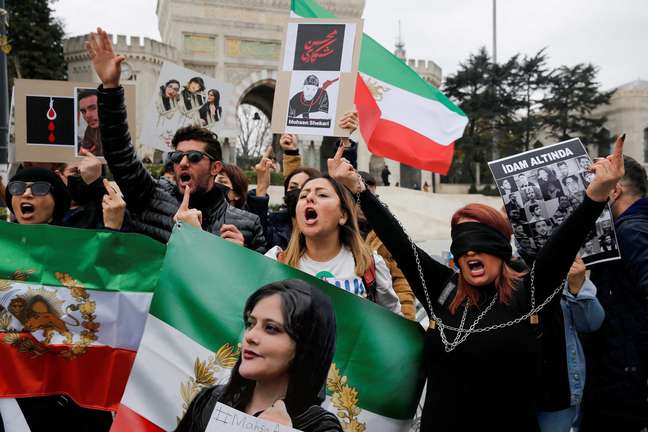Women are once again forced to wear the hijab inside the cars that travel the country’s roads; country has been the subject of protests for more than 100 days

OR Want has returned to monitoring the wearing of the hijab by women inside cars on the country’s roads, local media reported on Monday. 2 The tightening of surveillance on Islamic clothing comes after a short period of moderation, obtained by the demonstrators who have been on the streets of the country for more than 100 days in the protests that began over the death of Mahsa Amini and evolved by adding other social needs.
Mahsa, a 22-year-old Kurdish woman, died on September 16 in an Iranian prison after being arrested by the Islamic morality police for allegedly violating the dress code imposed on women in the country. The repercussions of her death, which human rights activists attribute to alleged ill-treatment by the police, prompted the authorities to decree an end to the moral police and to ease their vigilance.
A senior Iranian government official told the Iranian News Agency distant that the police have returned with the surveillance program, dubbed Nazer-1 (“surveillance” in Persian), across the country. According to the government, women who do not wear the hijab inside the car will receive a message on their mobile phone with the following text: “A lack of headscarf has been detected in your car. You must comply with society’s norms and not repeat this deed.” . The message also warns that legal measures will be applied if the situation repeats itself.
The program was rolled out in 2020 to be exercised by the Gasht-e Ershad (“driving patrols” in Persian), as the country’s moral police are called. In early December 2022, Iranian Attorney General Mohammad Jafar Montazeri said police units had been disbanded and surveillance had been reviewed.
Protesters and human rights organizations were skeptical of Jafar Montazeri’s announcement as it was a response to a question posed during a press conference and not a directive from the Interior Ministry.
Protester sentenced to death
In parallel with the reinstatement of tighter surveillance, Iran’s Supreme Court on Monday upheld the death sentence of a man involved in the country’s ongoing protests. According to the Iranian Judicial Agency Mizan, the man stabbed a security officer with a knife and participated in a protest in the city of Pakdasht that ended with a fire in the seat of local power. The agency also says that he was convicted because “he sowed terror among citizens”.
Iranian justice says it has sentenced 11 people to death by December for their participation in protests, but human rights organizations believe the number is higher.
Understanding the protests in Iran
After Mahsa Amini’s death, thousands of mostly young women in Iran took to the streets and burned their Islamic clothing in one of the largest demonstrations in defiance of Islamic rule and calls for greater individual freedoms. The demonstrations have evolved and other important sectors of the country, such as oil workers, have joined other demands, more related to the socio-economic situation of the country.
The chants that are heard in the streets bear the slogans “Women, Life, Freedom” (or Zan, Zendeghi, Azadi, in Arabic) and “Death to the dictator”, in reference to Ayatollah Ali Khamenei, Iran’s supreme leader.
In response, the country’s security forces shot Iranians in broad daylight, as shown in videos circulated on social media and verified by various Western organizations and newspapers, such as the The New York Times, and pursued protesters. Without the expected demobilization, the government caved in and temporarily weakened surveillance. /AFP
+The best content in your email for free. Choose your favorite Terra newsletter. Click here!
Source: Terra
Camila Luna is a writer at Gossipify, where she covers the latest movies and television series. With a passion for all things entertainment, Camila brings her unique perspective to her writing and offers readers an inside look at the industry. Camila is a graduate from the University of California, Los Angeles (UCLA) with a degree in English and is also a avid movie watcher.



![Such an excellent sun in advance: Summary of Episodes of Friday July 4, 2025 [SPOILERS] Such an excellent sun in advance: Summary of Episodes of Friday July 4, 2025 [SPOILERS]](https://fr.web.img6.acsta.net/img/9e/75/9e7594722fc6abc864fd31dfdcfe0110.jpg)
-ts56r2epzzvq.png)

